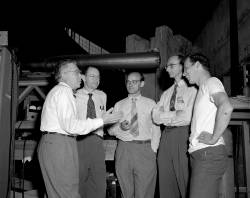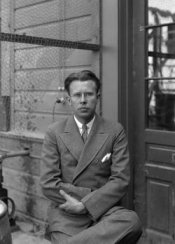

E. Lawrence
The 600 MeV Synchro-Cyclotron (1957) was CERN's first accelerator

Surrounding Edward Lofgren (center), head of the Bevatron, are discoverers of the antiproton, (left to right) E.Segre, C.Wiegand, O. Chamberlain and T.Ypsilantis.
From 1928 to 1995
1954:
power tools
The search for antiprotons heated up in the 1940s and 1950s, as laboratory
experiments reached ever higher energies...
In 1930, Ernest Lawrence (Nobel Prizewinner in 1939) had invented the cyclotron, a machine that eventually could accelerate a particle like a proton up to an energy of a few tens of MeV. Initially driven by the effort to discover the antiproton, the accelerator era had begun, and with it the new science of "High Energy Physics" was born.
It was Lawrence that, in 1954, built the Bevatron at Berkeley, California (BeV, at the time, was what we now call GeV). The Bevatron could collide two protons together at an energy of 6.2 GeV, expected to be the optimum for producing antiprotons. Meanwhile a team of physicists, headed by Emilio Segre', designed and built a special detector to see the antiprotons.
In October 1955 the big news hit the front page of the New York Times: "New Atom Particle Found; Termed a Negative Proton". With the discovery of the antiproton, Segre' and his group of collaborators (O. Chamberlain, C. Wiegand and T. Ypsilantis) had succeeded in a further proof of the essential symmetry of nature, between matter and antimatter.
Segre' and Chamberlain were awarded the Nobel Prize in 1959. Only a year later, a second team working at the Bevatron (B. Cork, O. Piccione, W. Wenzel and G. Lambertson) announced the discovery of the antineutron.


